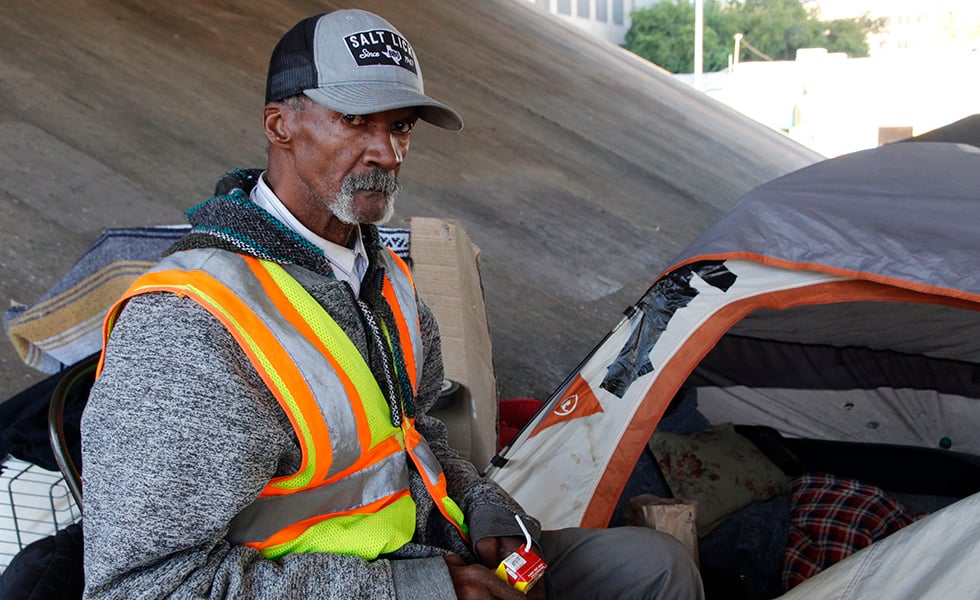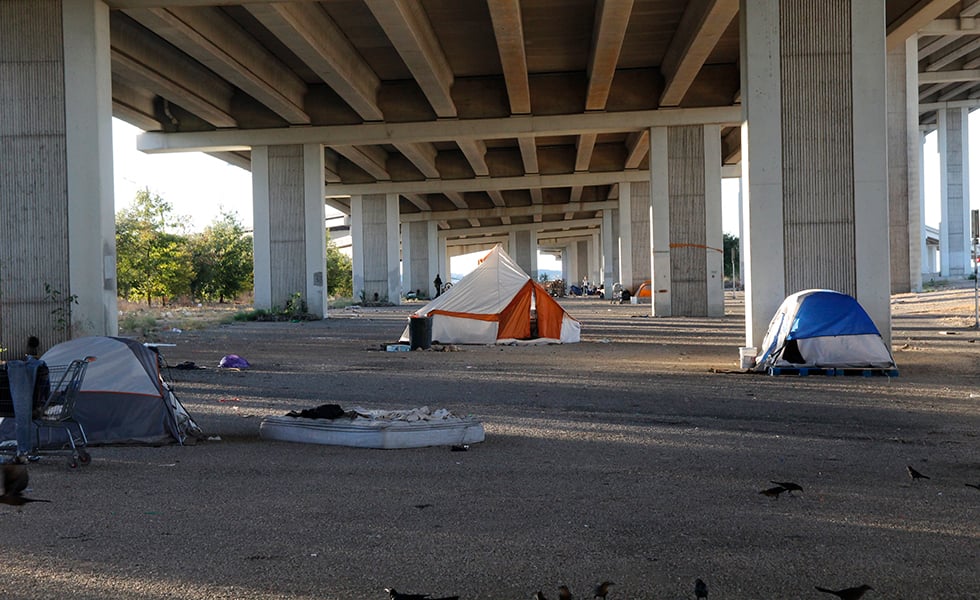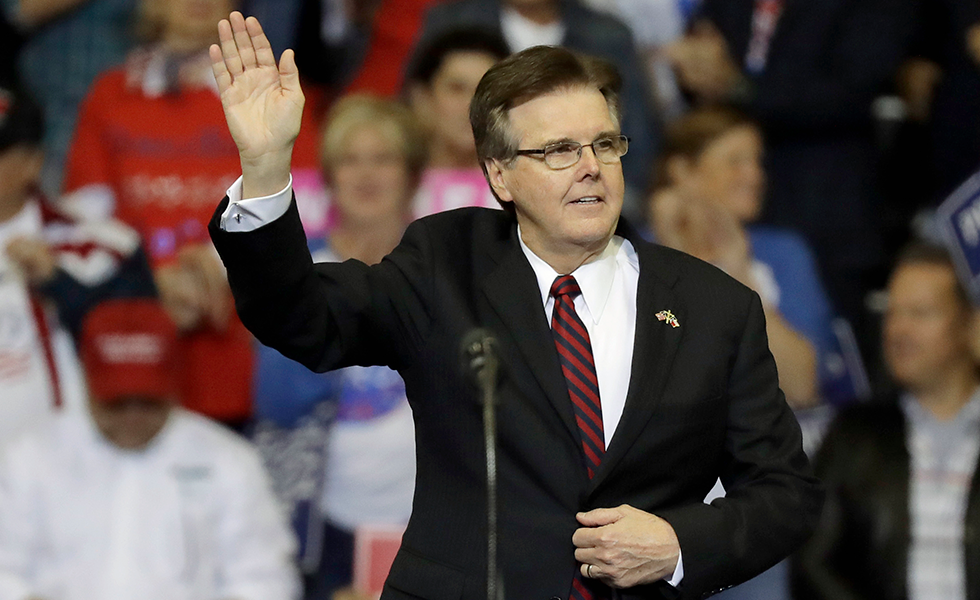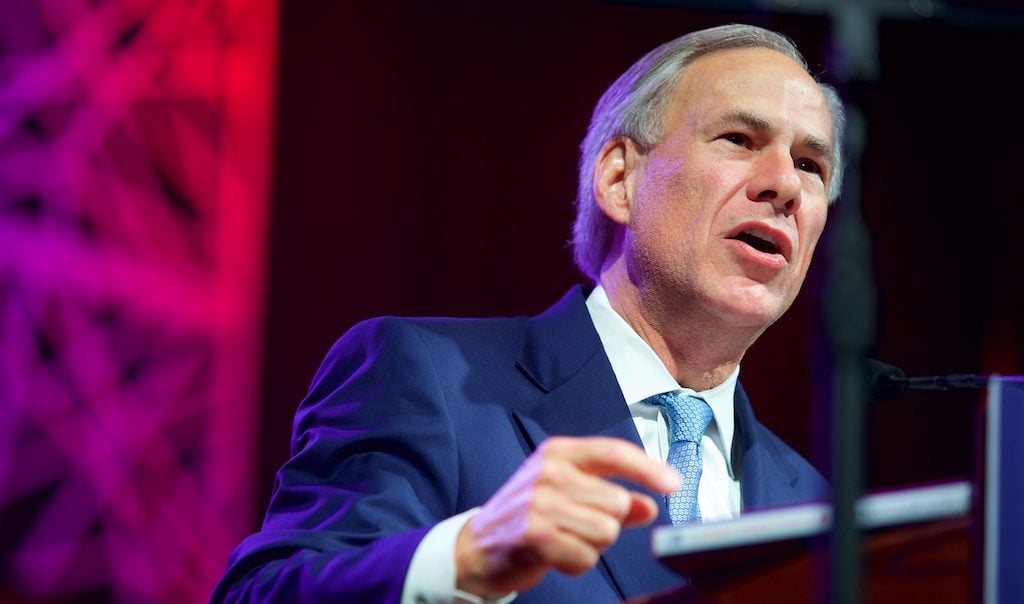
COVID-19 Reveals the Urgent Need to House the Homeless
As state and local governments scramble to provide the homeless access to rooms in order to save them (and us) from the coronavirus pandemic, it’s worth keeping one eye on the future.

Above: Erroll Crawford says he's a Vietnam veteran originally from New Orleans, who was first made homeless by Hurricane Katrina.
For weeks, advocates and news outlets have been sounding the alarm: The homeless are profoundly vulnerable to the COVID-19 pandemic. The disease is a new and urgent problem that demands emergency solutions, but the crisis should also etch into our minds something that was always true. Housing is inseparable from health care.
Consider the standard COVID-19 advice. Put distance between yourself and others. Wash your hands often. Stay home. With an apartment or house of one’s own, those directives are relatively easy to follow; otherwise, it’s exceedingly difficult.
Around the nation and Texas, homeless shelters are scrambling to find hygiene products and to create space between their residents. It’s a Sisyphean task. There are more than half a million homeless people in America and 25,000 in Texas; a shelter’s job is to harbor as many of them as possible. By the very nature of their work, many shelters must either violate social distancing—meaning their crowded facilities could become hotbeds for the virus—or turn folks out into the streets.
“To maintain a 6-foot distance between people, we would have to evict half our residents, and they have no place else to go,” says Blake Barrow, director of the 190-bed Rescue Mission of El Paso. Barrow is monitoring residents’ health closely, but he lacks face masks and infrared thermometers, and monetary donations have tumbled apace with the financial markets. At the 130-bed ARCH shelter in Austin, director Greg McCormack says he’s spread beds a tad farther apart and residents now sleep head-to-toe, but he’s short on even basic supplies like hand sanitizer. “There’s only so much we can do,” he says.
Then, there’s the more than 200,000 homeless people nationwide and 11,000 in Texas who live “unsheltered.” In outdoor encampments, the unhoused may be able to spread out more, but access to hygiene products and information is starkly limited.

On Sunday, the Centers for Disease Control and Prevention issued guidance that local governments should stop clearing out homeless encampments to avoid scattering potentially infected individuals. The guidance also calls for provisioning camps with handwashing stations and portable toilets, plus encouraging campers to maintain 12 square feet of space per individual. Advocates are celebrating the CDC’s advice, and cities including Austin and Dallas have suspended camp clearouts. For the past two weeks, the state has called off the governor’s cleanups too. In Austin, The Other Ones Foundation is operating a mobile hygiene clinic that visits camps on a rotating basis to offer showers and toiletries.
But full implementation of the CDC guidance will be tricky: Hygiene items are in short supply, and even local governments are struggling to acquire them. Meanwhile, many agencies and nonprofits have scaled back outreach to camps due to the virus. And even in the best-case scenario, a camp is still a poor facsimile of actual housing.
Some state and local governments are moving to get more homeless people off the streets without shoving them into overcrowded shelters. California’s governor has authorized $150 million to, among other things, pay for hotel rooms and travel trailers. In Minnesota, Hennepin County recently moved 130 people into hotels; in Dallas, city officials reserved 50 hotel rooms. Largely empty thanks to the pandemic, hotel rooms are well-suited for both social distancing and quarantine of those who’ve caught the virus. In the Senate’s most recent coronavirus stimulus bill, unveiled Wednesday, up to $4 billion is available for such emergency measures.
“This is one of the vulnerable populations that we should be really paying attention to,” says Eric Samuels, president of the Texas Homeless Network. For myriad reasons, the unhoused are likely to suffer severe cases of COVID-19 and end up needing precious hospital beds. A large share of people experiencing homelessness are over 50 years old; many have compromised immune systems from conditions such as diabetes; and chronic sleep deprivation undercuts the body’s defenses too. Beyond that, it’s a question of public health. “If the virus spreads within this community, it will spread outside this community,” Samuels says. “We have to get on top of this now. ”
“To maintain a 6-foot distance between people, we would have to evict half our residents, and they have no place else to go.”
But as we (hopefully) scramble to provide the homeless access to rooms of their own in order to save them and us from the current pandemic, it’s worth keeping one eye on the future.
Long-term homelessness is disastrous for the human body. Some researchers have found that chronic homelessness prematurely ages the body 10 to 20 years. And because unhoused people often rely on emergency rooms for care, the rest of us end up paying the price as well. Advocates have been making the argument for years that much of what we don’t spend on housing gets spent policing and jailing the homeless, or on treating their health emergencies. “It’s much more effective for public health and more economically effective to give people housing,” says Eric Tars, legal director of the National Law Center on Homelessness and Poverty.
The unhoused population—per the admittedly flawed “Point-in-Time count”—has now reached its highest level in both the nation and Texas since 2014. Once this crisis passes, are we going to return to the status quo? Are we going to send people from their newfound hotel rooms, or other temporary housing, back to the streets?
As always, doubters will claim that many homeless “choose” to be unhoused because of drug and alcohol addictions or to avoid work. But in a country where only one in five people who qualify for federal housing assistance actually receive it, such arguments are not even relevant.
Maybe COVID-19 could be the breakthrough homeless advocates have long hoped for. Maybe, when the next pandemic strikes, homelessness could be one less crisis to handle.
Find all our coronavirus coverage here.
Read more from the Observer:
-
Loneliness in the Age of Coronavirus: As a single parent, I was already struggling with loneliness. Then the coronavirus hit.
-
The New U.S. Food Safety Czar is a Texas Researcher with Close Ties to the Meat Industry: Mindy Brashears’ confirmation comes at a time when Americans are scouring supermarket aisles for safe food to eat.
-
COVID-19 Could Be a ‘Double Whammy’ for Those in Pollution Hotspots: Texans who breathe polluted air are more likely to have preexisting health issues. That means they’re at a higher risk of getting seriously ill from the coronavirus.


